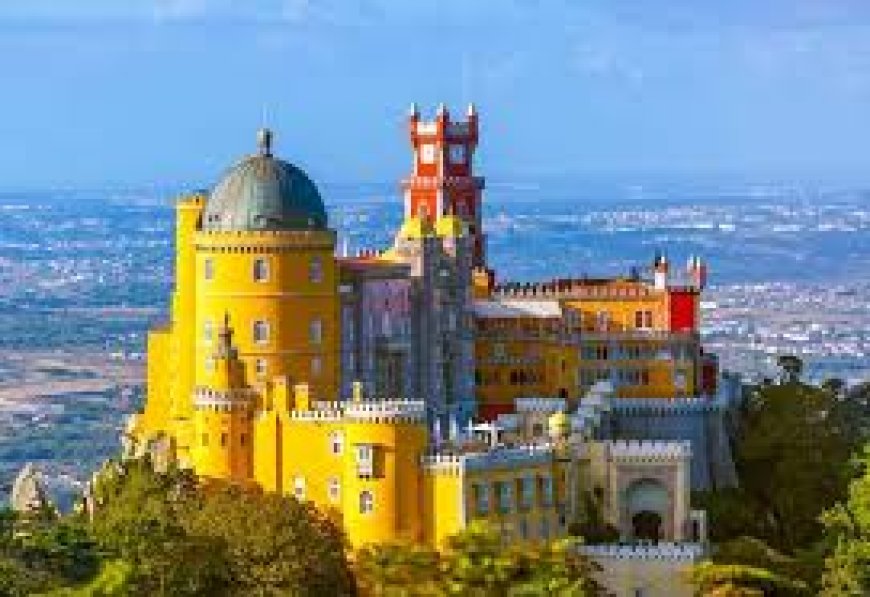Discover Portugal: Must-Visit Places from Lisbon to the Algarve
Portugal, with its rich history, stunning landscapes, and vibrant culture, is a country that offers a diverse array of attractions for travelers.

From the charming streets of Lisbon to the sun-drenched beaches of the Algarve, Portugal is a destination that promises both relaxation and adventure. In this article, we’ll explore some of the top places to visit in Portugal, including a special focus on the iconic Pena Palace.
1. Lisbon
Lisbon, Portugal’s capital, is a city of vibrant neighborhoods, historic landmarks, and stunning viewpoints. Start your exploration in the Alfama district, the oldest part of the city, where you can wander through narrow streets, enjoy traditional Fado music, and visit the historic São Jorge Castle.
The Belém district is another must-visit area, known for its iconic landmarks such as the Belém Tower and the Jerónimos Monastery. Don’t miss the chance to taste the famous Pastéis de Belém (custard tarts) from the original bakery.
For panoramic views of the city, take a ride on the iconic Tram 28 or head to Miradouros (viewpoints) like Miradouro da Senhora do Monte and Miradouro de Santa Catarina. Lisbon’s vibrant nightlife, with its numerous bars and clubs, ensures that the city remains lively long after sunset.
2. Sintra
A short drive from Lisbon, Sintra is a fairy-tale town renowned for its romantic architecture and lush landscapes. One of the highlights of Sintra is the Pena Palace (Palácio da Pena), a colorful and whimsical castle perched on a hilltop. This 19th-century palace, designed by German architect Ferdinand von Sette, is a stunning example of Romantic architecture and offers breathtaking views of the surrounding countryside.
The palace’s vibrant hues, eclectic mix of architectural styles, and beautifully landscaped gardens make it a truly enchanting experience. Inside, the ornate rooms and lavish interiors reflect the grandeur of its royal past.
Sintra also boasts other remarkable attractions, such as the Moorish Castle and the Quinta da Regaleira, a mansion with mysterious gardens and intriguing symbolism.
3. Porto
Porto, Portugal’s second-largest city, is known for its rich cultural heritage and stunning riverside setting. The city’s historic center, a UNESCO World Heritage site, is characterized by its narrow streets, colorful buildings, and beautiful churches.
A visit to Porto wouldn’t be complete without exploring the Ribeira district, a picturesque area along the Douro River. Here, you can enjoy a leisurely stroll along the riverbanks, take a river cruise, or dine in one of the charming riverside restaurants.
Porto is also famous for its port wine, and a visit to one of the many wine cellars in Vila Nova de Gaia, just across the river, offers a chance to sample this renowned beverage. The Livraria Lello, one of the world’s most beautiful bookstores, and the historic São Bento Railway Station, with its stunning azulejos (ceramic tiles), are also must-see landmarks.
4. Douro Valley
The Douro Valley, a UNESCO World Heritage site, is renowned for its stunning landscapes and wine production. The valley, which stretches along the Douro River, is dotted with terraced vineyards and charming towns.
A visit to the Douro Valley offers opportunities for wine tasting, river cruises, and exploring picturesque villages like Peso da Régua and Pinhão. The region is famous for its Port wine, but you’ll also find a variety of other excellent wines. Many of the local quintas (wine estates) offer tours and tastings, allowing you to experience the region’s wine culture firsthand.
5. Algarve
The Algarve, Portugal’s southernmost region, is celebrated for its stunning coastline, golden beaches, and warm climate. The region offers a range of beach experiences, from the popular Praia da Rocha to the more secluded Praia da Marinha.
In addition to its beautiful beaches, the Algarve is home to charming towns such as Lagos and Tavira. Lagos, with its historic center and scenic cliffs, is a great spot for exploring picturesque coves and enjoying water sports. Tavira, known for its well-preserved architecture and Roman bridge, offers a more relaxed and cultural experience.
The Algarve is also renowned for its golf courses, with several world-class options available for enthusiasts.
6. Évora
Évora, located in the Alentejo region, is a city with a rich history that dates back to Roman times. The city’s well-preserved historic center is a UNESCO World Heritage site and features a wealth of architectural and historical treasures.
Key attractions in Évora include the Roman Temple, the medieval Cathedral of Évora, and the Chapel of Bones (Capela dos Ossos), a unique and somewhat eerie chapel decorated with human bones. The city’s charming streets, historic buildings, and vibrant local markets provide a glimpse into Portugal’s past.
7. Óbidos
Óbidos is a medieval town known for its well-preserved walls, narrow streets, and charming architecture. The town is often referred to as a “living fairy tale” due to its picturesque setting and historical ambiance.
One of the highlights of Óbidos is the Óbidos Castle, which offers panoramic views of the surrounding countryside. The town’s streets are lined with colorful houses, boutique shops, and traditional eateries. Óbidos is also famous for its Ginjinha (a cherry liqueur) served in chocolate cups, making it a delightful treat for visitors.
8. Madeira
Madeira, an archipelago off the northwest coast of Africa, is known for its rugged landscapes, lush vegetation, and mild climate. The island of Madeira offers a range of outdoor activities, including hiking, canyoning, and whale watching.
Funchal, the island’s capital, is a vibrant city with beautiful botanical gardens, a bustling market, and a picturesque harbor. The Laurisilva Forest, a UNESCO World Heritage site, is a must-visit for nature enthusiasts, offering unique flora and scenic hiking trails.
9. Azores
The Azores, a group of nine volcanic islands in the Atlantic Ocean, are known for their stunning natural beauty and outdoor activities. The islands offer a range of experiences, from exploring volcanic craters and hot springs to whale watching and hiking.
São Miguel, the largest island, is famous for its crater lakes, including the stunning Sete Cidades and Lagoa do Fogo. The island of Pico, known for its towering volcano, is a popular destination for climbing and exploring volcanic landscapes.
What's Your Reaction?
 Like
0
Like
0
 Dislike
0
Dislike
0
 Love
0
Love
0
 Funny
0
Funny
0
 Angry
0
Angry
0
 Sad
0
Sad
0
 Wow
0
Wow
0


















































